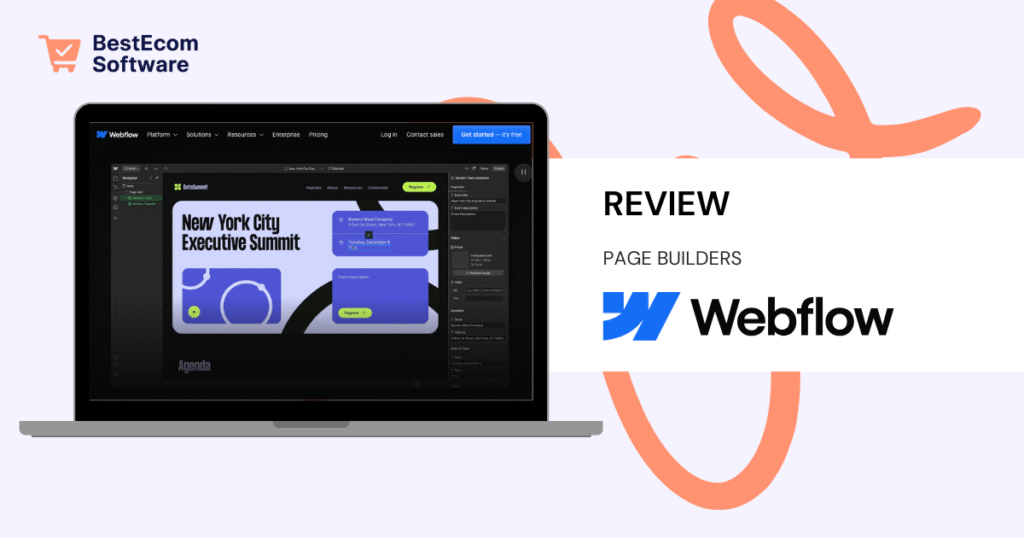Starting From
- Basic: $18/month – personal websites
- CMS: $29/month – content-rich blogs
- Business: $49/month – high-traffic, fast-loading sites
PROS
- Designer-level visual control and layout freedom
- CMS, animations, and hosting fully integrated
- Ideal for agencies, creatives, and pixel-perfectionists
CONS
- Steep learning curve for non-designers
- Multiple sites and ecommerce features raise cost
- Code export limits team migration flexibility
Webflow Review
Heads up: This Webflow review contains affiliate links—if you click and make a purchase, I may earn a commission. That said, I only recommend tools I’ve personally tested and found valuable.
Webflow is a modern, no-code platform designed for designers, developers, and marketers who want to craft fully custom websites—without touching a single line of code (unless they want to). It’s packed with powerful features like a visual HTML/CSS builder, integrated CMS, ecommerce functionality, and native animations. But Webflow isn’t for the faint of heart—it’s powerful, but comes with a learning curve, especially for non-designers.
So, is Webflow the right platform for your next site? Let’s break down its core capabilities, pricing structure, use cases, and where it really shines (or falls short).
Table of Contents
Quick Answers
- What is Webflow? A no-code website builder that gives full design control with integrated CMS and hosting.
- Who’s it for? Freelancers, agencies, marketers, and startups that want pixel-perfect custom sites without developers.
- Key features? Visual editor, CMS collections, animations, ecommerce, backups, SEO, and integrations.
- Compared to alternatives? More design flexibility than Squarespace or Wix, easier than custom coding.
- Easy to set up? Not bad with a template; full custom builds require time to learn the system.
- Integrations? Zapier, Google Analytics, Hotjar, MemberStack, and APIs.
- How much? From $18/mo (Basic) to $49/mo (Business) plus workspace or ecommerce fees.
- Pros & cons? ✅ Clean builder, robust CMS, no-code animations. ❌ Takes time to learn, can get expensive with scale.
- Worth it? Yes—if visual control, performance, and branding precision matter to you.
- Where to get it? Start with Webflow →
1. Features & Capabilities
Webflow delivers a robust suite of design and development tools in a visual UI. You get full control over CSS grid, flexbox, spacing, and layout. The CMS enables dynamic content creation like blogs, directories, or portfolios with collection lists and custom templates. No plugins needed—everything is built in and fully responsive out of the box.
It also supports scroll-based animations, page transitions, and Lottie integrations. Designers love the class-based styling and symbol features, which bring modularity and consistency to complex builds.
Webflow also shines with performance optimization—code is minified, lazy-loading is native, and SSL is free. You can even export code (with limitations) if migrating.
2. Pricing & Value
Webflow’s pricing is a bit complex: you pay separately for site hosting and account features. For most users, pricing breaks down into:
Basic
$18/month
- 50k monthly visits
- SSL & forms
- Simple site features
CMS
$29/month
- 100k monthly visits
- CMS items & collections
- Search & custom code
Business
$49/month
- High-traffic support
- Advanced SEO & backups
- Priority support
There are also ecommerce plans ($42–$212/month) and Workspace plans for agencies or teams. Price can climb quickly with more users, sites, or features, but the polish is hard to beat.
3. Ease of Use & Onboarding
If you’re coming from Wix, Squarespace, or WordPress, Webflow will feel both liberating and a bit overwhelming. The interface looks more like Photoshop or Figma than a traditional website builder. But once you learn how classes, containers, and breakpoints work, it’s an absolute joy to design with.
Templates make starting easy, and the Webflow University tutorials are best-in-class. Expect to invest a few hours up front to unlock its full power.
4. Case Studies & Reputation
Agencies rave about how fast they can ship client work, iterate designs, and scale content using CMS collections. Startups love that Webflow lets them build brand-polished pages without hiring developers.
Even enterprise brands (Dell, Rakuten, Upwork) have used Webflow for campaigns and microsites. But reviewers agree: it’s not for those who want “quick and dirty.” It’s for those who care about detail, performance, and custom branding.
5. Customer Support & Reliability
Webflow offers solid support via email and live chat. The community is active, and the documentation is thorough. Hosting uptime is consistently strong with global CDN and automatic backups included.
Enterprise customers get priority support and dedicated account managers.
6. Webflow Review Summary & Final Rating
Pros
Cons
Final Rating: ★★★★☆ (4.0/5)
Webflow is one of the most powerful website builders available today. It’s not for everyone—but if you’re a designer, marketer, or agency who wants a fully custom site without dev bottlenecks, it’s worth the investment.
